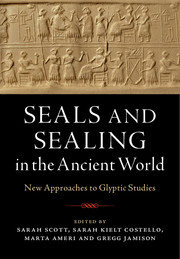 Seals and Sealing in the Ancient World
Seals and Sealing in the Ancient World Book contents
- Seals and Sealing in the Ancient World
- Seals and Sealing in the Ancient World
- Copyright page
- Contents
- Notes on Contributors
- Illustrations
- Plates
- Tables
- Acknowledgments
- Preface
- Abbreviations
- Chapter One Introduction: Small Windows, Wide Views
- Part I The Ancient Near East and Cyprus
- Part II South Asia and the Gulf Region
- Chapter Eight Indus Seals and Glyptic Studies: An Overview
- Chapter Nine Letting the Pictures Speak: An Image-Based Approach to the Mythological and Narrative Imagery of the Harappan World
- Chapter Ten Understanding Indus Seal-Carving Traditions: A Stylistic and Metric Approach
- Chapter Eleven Operational Sequences and Stamp Seals: A Preliminary Report on an Experimental and Microtopographic Framework for Identifying Groups of Seal Carvers in the Indus Civilization
- Chapter Twelve Seals and Sealing Technology in the Dilmun Culture: The Post-Harappan Life of the Indus Valley Sealing Tradition
- Part III Egypt
- Part IV Aegean
- References
- Endnotes
- Index
Chapter Nine - Letting the Pictures Speak: An Image-Based Approach to the Mythological and Narrative Imagery of the Harappan World
from Part II - South Asia and the Gulf Region
Published online by Cambridge University Press: 24 April 2018
- Seals and Sealing in the Ancient World
- Seals and Sealing in the Ancient World
- Copyright page
- Contents
- Notes on Contributors
- Illustrations
- Plates
- Tables
- Acknowledgments
- Preface
- Abbreviations
- Chapter One Introduction: Small Windows, Wide Views
- Part I The Ancient Near East and Cyprus
- Part II South Asia and the Gulf Region
- Chapter Eight Indus Seals and Glyptic Studies: An Overview
- Chapter Nine Letting the Pictures Speak: An Image-Based Approach to the Mythological and Narrative Imagery of the Harappan World
- Chapter Ten Understanding Indus Seal-Carving Traditions: A Stylistic and Metric Approach
- Chapter Eleven Operational Sequences and Stamp Seals: A Preliminary Report on an Experimental and Microtopographic Framework for Identifying Groups of Seal Carvers in the Indus Civilization
- Chapter Twelve Seals and Sealing Technology in the Dilmun Culture: The Post-Harappan Life of the Indus Valley Sealing Tradition
- Part III Egypt
- Part IV Aegean
- References
- Endnotes
- Index
Summary
The iconography of the Harappan world, particularly as seen in the seals, sealings, and molded tablets found at sites in the Indus Valley and beyond, includes a number of mythological characters and narrative scenes that have to date defied interpretation. Past attempts to deal with this material have tried to relate the imagery to contemporary Western Asian iconography or to later Hindu mythology, but with limited success. This chapter attempts to deal with the mythological and narrative iconography of the Harappan world on its own terms, not necessarily with the aim of interpreting it, but rather to understand the role that visual imagery may have played in embodying and propagating the belief systems of the Harappan world. By combining standard art-historical approaches with current theories of narratology, as well as with models provided by recent scholarship on fantastic and mythological creatures in antiquity, this chapter first defines the cast of characters found in Harappan iconography and then proceeds to examine the scenes in which they interact with each other or with the inhabitants of the “known” world. While many of these scenes have little meaning on their own, taken together they may provide hints to the narratives that underlay the mythology of the Harappan world, and how they were used within the Harappan system.
- Type
- Chapter
- Information
- Seals and Sealing in the Ancient WorldCase Studies from the Near East, Egypt, the Aegean, and South Asia, pp. 144 - 166Publisher: Cambridge University PressPrint publication year: 2018
- 1
- Cited by


